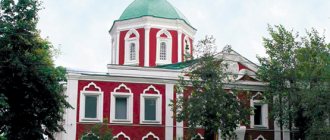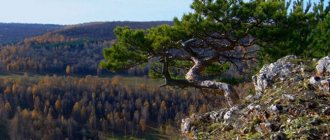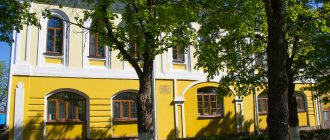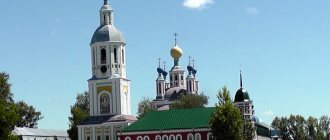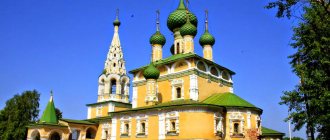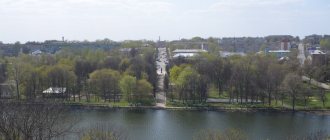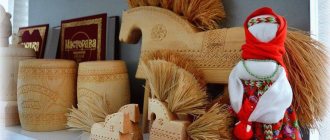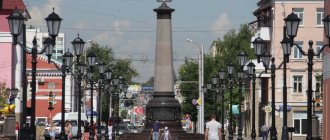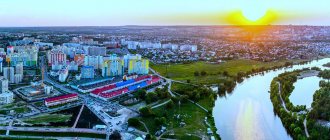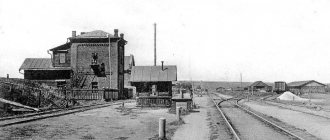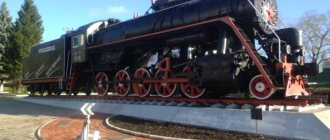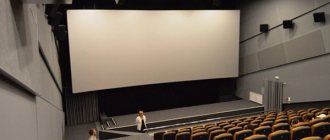Saransk was one of the cities that will organize the 2022 FIFA World Cup. It hosted thousands of guests and 4 games. Many considered the city unworthy to host such a major international event. Local residents of the capital of the republic disagreed with this and were offended by such statements. Is it true that Saransk is a big village that did not interest the fans? Let's try to figure it out by presenting the popular attractions of Saransk.
Saransk is the capital of Mordovia. This city is called the sports capital of the Volga region. After all, in Saransk there are many operating sports facilities, and many local residents are closely connected with sports.
For several years in a row, Saransk has become a prize-winner of the All-Russian competition “The most comfortable city in Russia.” Not bad for a “big village,” don’t you think?
Many tourists visited the capital of Mordovia and retained only positive memories in their memory. After all, Saransk is a very calm and beautiful city where you can see many attractions.
1
Cathedral Square
Let's start with the most important square of the city - Cathedral Square. It is located in the city center on Sovetskaya Street. The main decoration of the square is the Cathedral named after. F.F. Ushakov, which will amaze every guest of the capital with its beauty, grandeur and architectural execution.
Wonderful flowers are always planted along the square, which will lift everyone’s spirits. A shopping center has been built near Cathedral Square, where you can buy souvenirs or other products that interest you.
2
Park named after A.S. Pushkin
If you want to spend your holiday actively, then Park them. A.S. Pushkin is a place that you must visit. Attractions, playgrounds, stages for various concerts, cafes and restaurants where you can try traditional Mordovian cuisine.
And you can also take a lot of beautiful photographs in the park, because there are many sculptures, artificial ponds, and interesting buildings.
3
Church of St. John the Evangelist
This is perhaps one of the oldest buildings not only in the city, but in the entire region. The date of its construction is considered to be 1693, at which time Saransk did not even have the status of a city.
But in fact, the church has an even deeper history. Before the stone building, there was a wooden church here.
The church has a rather turbulent history, it was completed, adjusted, closed and even refurbished (in the 30s - 40s of the last century, the NKVD archive was located in the building).
5
The value of such architecture and why to love it
In the 20th century, Russian architecture underwent many changes. Ornamentally rich Art Nouveau gave way to constructivism with strict forms and no decoration. Then —
rethinking the classics during the reign of Stalin and the subsequent fight against excesses during the “thaw”.
The modernist utilitarianism of Brezhnev's stagnation closer to the 1980s is diluted by timid Soviet postmodernism, playing with meanings and forms. And the collapse of the socialist system and the transition to a market economy gave rise to a confident direction of post-Soviet postmodernism -
capitalist romanticism.
Closer to the beginning of the 2000s, regional varieties of caprom were formed in different regions of Russia and the former countries of the socialist camp. In Belarus there is an agro-renaissance, in Moscow there is the Luzhkov style. St. Petersburg was marked by glassism, named after the former governor. Saransk has its own vibe - folk-metropolitan, combining rainbow village colors with classical rigor.
From the point of view of accepted aesthetic normativity, the architecture of Saransk can well be called tasteless. But the socio-cultural and political significance of the center, rebuilt in the style of kaprom, is amazing. This is a very clear reflection of its time. The material embodiment of the well-fed noughties with an admixture of Mordovian identity.
The era of capitalist romanticism is over. In some regions its residual influence is still felt, but general architectural trends convincingly show that the vector is again pointing towards greater utilitarianism and simplification. No one will return to the 2000s; the buildings of that time are unique. Therefore, from a cultural point of view, they are no less significant than any other historical architecture. To paraphrase the iconic words of Leonid Parfenov, we can say that Saransk is something without which it is impossible to imagine us, and even more difficult to understand.
- Author of the guide: Alexander Semenov
- Photos: Alexander Semenov, Misha Mityukov
Subscribe to us on social networks : telegram channel, Vkontakte, Facebook, Yandex.Zen, Instagram.
Temple of the Kazan Icon of the Mother of God
Like any modern prosperous city in Russia, Saransk boasts not only new shopping centers and office buildings, but also objects of cultural and religious significance.
One of such objects is the Temple of the Kazan Icon of the Mother of God, built in 2011. This is a modern building, made according to all the canons of the Orthodox faith. The temple is beautiful both inside and outside. It blended harmoniously into its surroundings, becoming the center of attraction for thousands of parishioners.
6
LiveInternetLiveInternet
Monday, April 28, 2014 11:52 + to quote book -Juliana-
all posts by the author
Saransk (Moksh. Saranosh, Erz. Saran osh) is a city in the eastern part of Central Russia, the capital of the Republic of Mordovia. Located on both sides of the Insar River (Volga basin), 642 km (500 km in a straight line) southeast of Moscow. The area of the city is 71.5 km². Founded in 1641, it received city status in 1780. City Day is celebrated on June 12. coat of arms of the city of Saransk Saransk arose on the shore, surrounded by large sars. The Saranka River, called Sarley in the 17th century, formed a huge swampy area near the city. The word Saransk is based on the word sara - swamp. To put it simply, the name Saransk means a place in the swamps and the city got its name from the name of the Saransk River, which arose earlier.
Saransk was founded in 1641 as a fortress on the southeastern outskirts of the Russian kingdom, on the Atemar abatis line, which was part of a large fortified line built from 1638 to 1653 and stretching from Belgorod to Simbirsk. House of Soviets of the Mordovian Autonomous Soviet Socialist Republic On the eastern side of the square in front of the square there is the House of Soviets of the Mordovian Autonomous Soviet Socialist Republic. It was built a little away from the former Spassky Cathedral, destroyed in the 30s. Millennium Square
On August 24, 2012, Millennium Square was officially opened in Saransk. It can undoubtedly be called the heart of the city, the new calling card of Mordovia. The square forms a single space from the National Library. A.S. Pushkin to the Universal Hall. New building of the first building of Moscow State University. N.P. Ogareva. Shopping and entertainment complex "Ogarev Plaza" "Ogarev Plaza" is located in the very center of Saransk at the intersection of Bogdana Khmelnitsky and Bolshevistskaya streets. The total area is 9396.4 m2. This 5-story building has 2 entrances from the street, all floors are connected by 10 escalators and 2 panoramic elevator. The “pearl” of the square was the color and musical fountain “Star of Mordovia,” which has no analogues in Russia. An effective addition to the water jets is color and musical accompaniment; in addition, the fountain is equipped with a so-called “barefoot zone”, where the water level is 2-3 cm and where anyone can take off their shoes and take a walk. Also, according to the project, in the dark, it is possible to transmit an image to a vertical sprayed surface of water. The height of the fountain jets exceeds 40 meters! Until the 18th century, Saransk was divided into settlements, which were also fortified. The city was built in separate estates in two rows along the main roads. Saransk grew quite quickly and developed not only as a military center, but also as a trade and craft center. By the early 60s of the 17th century, the borders of Saransk had already extended to the lands south of the Saranka River and on both sides of the Insary River. Saransk city center. “White House” “White House” is a high-rise building of the former Mordovian regional committees of the CPSU and Komsomol. It was built in the form of a complex plastic 9-storey volume and a one-storey part, with a courtyard, two halls for 400 and 200 seats. It is made of brick, the outer sides of the walls are lined with white limestone tiles. Based on the color of the cladding, it is called the “White House.” Railway station Saransk railway station is the main gate of the city. It is located on the Ruzaevka - Arzamas section, in the center of the city of Saransk and connects the main passages of the Gorky and Kuibyshev railways. Station Square On December 7, 1990, the Mordovian Autonomous Soviet Socialist Republic was transformed into the Mordovian Soviet Socialist Republic, Saransk remained its capital. In 1991, Saransk became the capital of the Republic of Mordovia. The unpreparedness of Saransk enterprises for a market economy led to a significant decline in the socio-economic development of the city. Healthcare, educational, cultural and other institutions found themselves in the same difficult situation. National Library named after A.S. Pushkin Stone in honor of the Millennium of the unity of the Mordovian peoples with the peoples of Russia in front of the National Library. A.S. Pushkin The economic boom in the early 2000s, observed in Russia, was also reflected in Saransk. Recently, there has been significant development of urban infrastructure. A new Yubileiny stadium, several large residential areas, hotels and other facilities are being built. Construction of two ring roads and a direct route between the urban settlement is underway. Nikolaevka and one of the central arteries of the city - Polezhaeva Street. State Opera and Ballet Theater fountain next to the Opera and Ballet Theater Currently, industry still plays a key role in the city's economy. Among the most developed industries are mechanical engineering, metalworking, instrument making, electric power, non-ferrous and ferrous metallurgy, chemical industry, machine tool building, production of building materials, light industry, and food industry. Museum of Mordovian Folk Culture
The Museum of Mordovian Folk Culture was opened on October 6, 1999. It is located in Saransk at the address: st. Sovetskaya, 19 in a building that is a monument to provincial urban architecture of the early twentieth century. Until 1917 it belonged to the Saransk merchant and entrepreneur K.Kh. Barablinu. Mordovian Republican Museum The Mordovian Republican Museum of Fine Arts named after S.D. Erzya is one of the largest cultural, scientific and educational centers in the Volga region. Mordovian National Drama Theater Began its professional life in 1989. Its repertoire includes original drama by Mordovian authors, as well as world and Russian classics. fountain near the Mordovian National Drama Theater Russian Drama Theater A very beautiful fountain in the form of a blossoming bud is located in front of the Drama Theater on Theater Square. There are flower beds around and benches where you can relax and admire the beauty of the fountain. In the dark, the composition is illuminated and creates the feeling of a scene from a fairy-tale performance. The building of the Main Post Office Military Commissariat From the Square of Glory, People's Friendship Square, founded in 1985, was celebrated, when the 500th anniversary of the entry of the Mordovian people into the Russian state was celebrated. The expressive monument “Forever with Russia” was erected here. HISTORICAL_ARCHITECTURAL MONUMENTS OF SARANSK There are many historical and architectural monuments and other attractions in Saransk. Victory Square received its official name by decision of the City Council on May 6, 1972. Located in the central part of the city on the street. Sovetskaya, bounded by st. Bolshevik and L. Tolstoy. A monument to the soldiers of Mordovia who fell during the Great Patriotic War was erected on the square. The monument was opened on May 9, 1970, on the day of the 25th anniversary of the victory over Nazi Germany. Monument to Internationalist Soldiers
The monument to internationalist soldiers was erected on Victory Square in 2005. The authors of the monument are architect V.A. Brodovsky and sculptor N.M. Filatov. Mother Mordovia blesses her son-warrior for a feat of arms. The composition of the monument is simple and solemnly strict: Mother Mordovia blesses her son-warrior for a feat of arms. A stately woman in national dress hands a sword to her kneeling son-soldier. An eighteen-meter granite pylon is installed nearby. There is an inscription on it: “Eternal glory to the soldiers who died in the battles for the freedom and independence of the Soviet Motherland in the Great Patriotic War of 1941-1945.” You took your own life to save a life. Your feat, Your names are forever in the hearts of the Grateful people.” On the site of the monument, framed by a star, the fire of Eternal Glory burns.
In the park at the entrance of secondary school No. 4, instead of the old one, a new monument to the Young Guard Hero of the Soviet Union Oleg Koshevoy was erected. Made of metal on a concrete base according to the plan of the school director A.P. Tarlykov. Monument to pioneer heroes “Eaglet” Located in the city center at the intersection of Sovetskaya-Proletarskaya streets, not far from the State Russian Drama Theater of Mordovia. In memory of the military exploits of fellow aviators who bravely defended our Motherland from fascist invaders during the Great Patriotic War of 1941-1945. Installed on the day of the XXX anniversary of the Victory on May 9, 1975. Soviet square. Monument to V.I. Lenin On holidays and memorable days on Sovetskaya Square. There are demonstrations, rallies, processions, and celebrations of workers. It has become a tradition to install the city’s main Christmas tree here on New Year’s Eve.
Monument to the poet, revolutionary democrat A.I. Polezhaev is made of amazing pink granite
monument to Emelyan Pugachev From July 27-30, 1774, Emelyan Pugachev entered Saransk with his army, whom the residents met with great honors and supplied the rebels with horses, fodder and food
If you come to Saransk by train, then on the station square you will see a monument to the stratonaut heroes. On a high round pedestal stands a bronze figure of a young man looking up. No matter from which side you look at this figure, the impression is the same, his hands will now become wings, and he will fly far to the stars. The monument to the stratonaut heroes was erected in the city of Saransk on the square in front of the railway station on January 30, 1963. Who are the heroes of the stratonauts? On the pedestal there are bas-relief portraits of the conquerors of the stratosphere Pavel Fedoseenko, Andrey Vasenko and Ilya Usyskin and the inscription “To the Stratonaut Heroes.” It was they who began to pave the way into space. This monument is a symbol of courage, romance, thirst for achievement. It is as if he welcomes the guests of the city and calls everyone to a feat in the name of the prosperity of our Motherland. The squares, squares and streets of the central part of Saransk are richly decorated with sculptural monuments. On the Moscow Descent, where a wooden watch tower stood in the 17th century, in 1982 a sculptural composition dedicated to the builders of the Saransk Fortress was erected. Monument USSR QUALITY SIGN and MAN OF LABOR This is the very State Quality Mark, confirming that this product was produced according to all standards and corresponds to a high level of production. A sculptural composition called “Make yourself at home” According to the Directorate of Public Utilities and Improvement, the sculptural composition is a collective image of hospitality and comfort. A bronze chair with a cat sitting on the back and slippers have become a symbol of home coziness, comfort and relaxation. A coat is casually thrown over the chair, a cap lies on top, and a suitcase stands on the floor - a symbol of travel.
Family Monument A family monument is a symbol of unshakable values that are and will be the foundation of society. Two adults - mom and dad, and next to them are children - the eldest daughter, son and youngest, plus another baby in the womb.
sculpture “New Life” There comes a moment in the life of parents when their child asks questions: “Daddy, mommy, where do children come from? How was I born? How did you know my name?” In response, parents tell their little ones stories about babies being brought by a stork or bought in a store. And yet the most popular version remains that parents discovered them in cabbage. Established on June 10, 2011. To the beloved city in the year of celebration of the 370th anniversary of its founding in 1641. The fox is a symbol of cunning and deceit. But, also, it is a symbol of a subtle, sophisticated mind, insight and mockery. Many peoples have endowed the fox with these symbols, comparing the habits of the fox with the characteristics of human character. apparently, a janitor... sweeps well, clean. Within the city there are several large sports facilities: the Olympic Training Center of the Republic of Mordovia for race walking, two sports complexes, a sports and entertainment complex, a Sports Palace, an ice palace, two stadiums, and so on... The Aquatics Palace sports Stadium "Start" Stadium "Start" is a sports facility in the city of Saransk, the capital of the Republic of Mordovia, built in 2004. Next to the stadium there is a pond with a beach and two courts for playing beach volleyball. For the active population, there is a rental of roller skates, boats, catamarans, skates, and skis. In winter, a skating rink for public skating is built on the territory of the complex; in summer, open air events are held on the beach. Ice Palace The Ice Palace is one of the calling cards of our city. This is a unique building not only for our city, but also for Russia, because... The most modern equipment was used for its construction, and it was built in the shortest possible time - in two years. Stela with a soccer ball near the construction site of the Yubileiny stadium for the 2022 FIFA World Cup in Saransk FOUNTAIN Descent
The fountain descent to the park of culture and recreation named after A. S. Pushkin is the very first fountain ensemble in Saransk. Monument to A.S. Pushkin The composition was installed in 2001 for the 200th anniversary of the poet. The recognizable silhouette of the young poet is inscribed in a lovely arch with a soaring muse. The genius enters through the gate into open space and peers into the boundless world.
The forged decorative composition “Flowers of the Millennium” is a bouquet of flowers about two meters high, made by blacksmiths using old Russian technologies. “Flowers of the Millennium” were placed on a granite pedestal and organically fit into the cascade of Saransk monuments. The fountain descent features cascading fountains decorated with beautiful flower beds. Three equidistant round fountains are located on the slope, and cascades stretch on the sides from Sovetskaya Square to the entrance to Pushkin Park. On holidays, fairs and sales of souvenirs, paintings and folk arts and crafts traditionally take place here.
In general, nothing colors the streets more than flowers and trees, even the most traditional ones. Every year new colorful fragrant flower beds appear. And the company celebrated the millennium of the unity of Russia and Mordovia, which was celebrated in August 2006, with a gift.
PARK OF CULTURE AND RECREATION named after. A.S. Pushkin Pushkin Park today is one of the best in Russia. The park has become a place of recreation for people of different ages, interests and passions, the pride of our capital, the main venue for large-scale events. Its shady alleys, a thick carpet of fragrant flowers, and clean air attract visitors on weekdays and weekends.
Time running. Children's locomotives in Saransk. On the reservoir of the park of culture and recreation named after A. S. Pushkin. The modern territory of the park named after. Pushkin is located on the former Assumption Square. Assumption Square was named after the Assumption Church, built in the first half of the 18th century. The area of the park is almost 40 hectares. The park includes three areas: a recreation area, an attraction area, and an event area. All vacationers in the park can enjoy cotton candy, enjoy delicious ice cream, meet the fairy-tale characters of Pushkin Corner, and feel the unforgettable harmony of “Duck Island”. The modern park has three brands - a Ferris wheel, a brass band, which gathers its spectators every Saturday, and the “Merry Little Engine”, so loved by both children and adults. Once you have visited the park, you will understand that no story about it can replace the vivid, indelible impressions, warm and bright feelings received from communicating with nature, riding on attractions, and seeing cultural programs.
8 Park A. S. Pushkin. Ferris wheel. A reservoir near the park named after A.S. Pushkin Until recently, only one definition was suitable for this body of water - “Gutter”, but the head of the city decided to clean and bring everything into divine shape. Now a reservoir near the park named after A.S. Pushkina “shines” with its purity and beauty.
monument to Vladimir Vysotsky in the city park of culture and recreation. Pushkin Everyone can even go boating. The only thing is that you still can’t swim in this reservoir - it’s low, and there’s a private sector and a road all around. In winter, the pond is turned into a skating rink and everyone who is not too lazy can relax on skates for their own pleasure.
Saransk city center
Lenin Avenue and Kommunisticheskaya Street. Lev Tolstoy.
Sovetskaya st. (1918), ex. Bazarnaya Bazarnaya was considered the main street of the city. But despite this, it differed little in terms of amenities from other streets. After the October Revolution, on November 1, 1918, Bazarnaya was renamed Sovetskaya Street. From that time on, the next stage of her biography began.
Bogdan Khmelnitsky Street
House of Public Service, trade and office complex Botevgrad Bridge The bridge over the Saranka River went into operation at the end of 1981. It has become a tradition for all newlyweds to visit this bridge. The groom carries the bride in his arms, which symbolizes overcoming difficulties together and a happy life. According to tradition, glasses are broken here for good luck.
Crossroads Voinova Street and Kovalenko Street. Avenue 60 Let Oktyabrya st. Communist and Hotel "Saransk" Hotel "Saransk" opened its doors to its first guests in December 1979. Its location is very convenient and prestigious: it is located in the historical and business center of the city, next to state and government institutions, banks. Stela “Soccer Ball” In a cozy public garden located near the Saransk Hotel, a monument-installation in the shape of a soccer ball appeared. The stela is a forged decorative composition 5 meters high, decorated with the coats of arms of Mordovia, Saransk, as well as the logos of the company that made the creation of this composition possible. House of Finance Fountain on Kommunisticheskaya "Dandelion"
st. I.S. Kovalenko Ivan Semenovich Kovalenko (1927-1978) - organizer of lighting production in Mordovia, Honored Worker of Industry of the MASSR, Hero of Socialist Labor. Fountain "Tornado" on the street. I.S. Kovalenko “Tornado” is a geyser-type fountain that works with color and musical accompaniment. The latest technologies were used to create this fountain; the water supply in the decorative bowl is regulated by a special electronic program that helps create amazing compositions. Using a modern water flow control system, unique water effects of “explosions,” “shots,” and “fireworks” are created. At night, the fountain is illuminated by spotlights and shimmers with all the colors of the rainbow. Residents come here to relax and cool off during the hot season. Shop "Gulliver" on I.S. Kovalenko
City Children's Wedding Palace. Opened in 1992. Hall with 230 seats. Former cinema "Mordovia". Year of construction: 1958. Typical building of a post-war Stalinist cinema of the 50s with 300-330 seats. Entertainment complex Proletarsky Park Proletarsky Park of Saransk is intended for family recreation. A recreation and attraction area is equipped on an area of 8.5 hectares.
Here is the city's tallest Ferris wheel of 38 meters, an autodrome, a Sputnik roller coaster, a swimming pool with boats, the Flying Saucer, Extreme Storm attractions, the Fairy Tale Train rail track, the Flying Ship children's carousel, " Sunny”, “Helicopter” and the game complex “Fairytale Kingdom”.
interior of the Cathedral of the Holy Righteous Warrior Fyodor Ushakov Easter message of His Eminence Zinovy, Metropolitan of Saransk and Mordovia, to the pastors, monastics and all faithful children of the Church of Christ in the Saransk diocese April 19, 2014 After the canonization of Admiral Fyodor Ushakov by the Russian Orthodox Church in 2001, he was elected patron saint future cathedral. In agreement with the city authorities, the square at the intersection of Bolshevik and Sovetskaya streets was chosen as the location of the shrine. In 2002, the building was given the status of national significance and was supported by a number of private sponsors. On May 8 of the same year, the cornerstone of the building was laid. Construction was completed in 2006. On August 6, the object was consecrated by Patriarch of Moscow and All Rus' Alexy II. view of the Cathedral
Monument to Ushakov F.F. Monument to Admiral of the Russian Fleet Fyodor Fedorovich Ushakov on Cathedral Square. It is located opposite the Fyodor Fedorovich Cathedral. Monument to Patriarch Nikon. Next to one of the Orthodox churches in the center of Saransk, a monument was erected to Patriarch Nikon, who played an important role in the Christianization of the Mordovians. Although Patriarch Nikon was born in the village of Veldemanovo in the neighboring Nizhny Novgorod region, in Saransk he is considered the son of the Mordovian people. For his anniversary, a worship cross made of black marble with the inscription “To His Holiness the Patriarch of All Rus' Nikon from the Mordovian people” was installed on the site of the patriarch’s parental home. Temple of the Kazan Icon of the Mother of God The site for the construction of the temple was consecrated on December 23, 2000 by Archbishop Barsanuphius of Saransk and Mordovia. Construction began in the summer of 2001 and was carried out with donations from large industrial enterprises of the republic and private benefactors. The names of the donors are inscribed on the bricks that make up the walls of the temple. Russian Orthodox Church (Moscow Patriarchate)
Temple of the Icon of the Mother of God Joy of All Who Sorrow. Located in the South-Western district of Saransk, at the intersection of Ulyanov and Engels streets, in the square of the 4th city hospital. A chapel bearing the name of St. George the Victorious appeared in Saransk at the intersection of Kommunisticheskaya and Botevgradskaya streets. St. John the Theological Church One of the oldest monuments of Orthodox architecture in the Mordovian region is the St. John the Theological Church in Saransk. The brick building of the former parish church is located in the central part of the city on the street. The Democratic Church of St. John the Theologian is one of the few surviving examples of stone architecture of the late 17th century, which stylistically can be attributed to pre-Petrine architecture; the methods of reconstruction of the ancient Russian temple at the beginning of the 19th century deserve attention.
St. Nicholas Church
St. Nicholas Church, built on Posop in the mid-19th century, was previously considered a suburban church. Now she is located in the Khimmash microdistrict. Many people consider it heavy, massive, even somewhat boring. But it has its own charm. Museum-ethnographic complex “Mordovian Village” A museum-ethnographic complex was built on the territory (area of Saranskaya-Kavkazskaya street) in preparation for the celebration of the Millennium of the unity of the Mordovian people with the peoples of the Russian state. The complex itself includes a miniature copy of the farm of a village Mordovian family - a wooden house with an internal national design and a colorful courtyard setting - rural outbuildings, ancient household appliances, a small stylized pond, etc. The complex also plans to build a national cafe in folk style, which will be located on the pier - a site facing directly to Saranka. At the same time, the bed of the reservoir has been expanded and cleaned, and the banks have been strengthened. In the future, however, it cannot be ruled out that the museum-ethnographic complex will be replenished with other objects. In particular, the idea of recreating part of the fortress wall with a tower in this area was recently voiced. According to the plan, this is where training and demonstration performances by members of historical reconstruction clubs will take place.
Museum and ethnographic complex “Mordovian Compound” Almost 373 years have passed since the city of Saransk was founded. During this time, from a small fortress on a guard line, it grew into a modern beautiful city - the capital of the Republic of Mordovia. This vibrant city is small, its territory is 71.5 square meters. km, population – 320 thousand people. Most of the inhabitants are Russians, Mordovians, Tatars. But the point is not at all in size and quantity. The fact is that for many residents their city is their favorite and most beautiful. from here
| Categories: | Cities Attractions |
Tags:
wind of wanderings bright splendor of nature beauty of Russia Mordovia Saransk
Cited 5 times Liked by: 9 users
Like share
0
Like
- 9
I liked the post - Quoted
- 0
Saved
- Add to quote book
- 0
Save to links
Liked9
0
Other important sights of Saransk
The city will be able to satisfy all the desires of tourists. After all, there are theaters here: both for children and for adults; and museums, and shopping centers, and entertainment, and a wonderful and cozy atmosphere. Moreover, the most important attractions are located in one place, which allows you to avoid wasting time moving from place to place.
Mordovia is the birthplace of many world-famous personalities. And athletes, and actors, and sculptors.
Thus, in the capital there is the Mordovian Museum of Fine Arts named after S. Erzya. The museum's halls display the largest collection of works by the famous sculptor Erzya.
Historical and cultural monuments
Smolny National Park
Address: Smolny village, st. Topolei, 11A Phone: 8 (8343) 32‑74-65 Website: zapoved-mordovia.ru Opening hours: 00:00 – 00:00 Mon-Sun, Tue – day off Cost: entrance ticket from 100 rubles
Located in the Ichalkovsky and Bolshe-Ignatovsky districts of the republic, next to the Alatyr River. The Kalysha and Yazovka rivers flow through the park, merging with the Alatyr.
The park was opened in March 1995. Currently, its area is more than thirty-six hectares, on which broad-leaved and coniferous forests grow. The park is home to fauna that is protected due to the threat of extinction. In some places the park area is swampy.
The park annually hosts scientific forums and conducts research expeditions aimed at studying the life activities of local inhabitants.
Many social projects at the republican and all-Russian levels are being implemented here.
Let's sum it up
Saransk is the cultural capital of the republic, which is not a shame to show to foreigners. Despite the fact that the city is relatively small, it contains many interesting attractions.
The editors of most-beauty.ru ask you to write in the comments what other attractions of Saransk you would include on our list.
Editor's note: This article has been updated since its original publication in September 2022.
